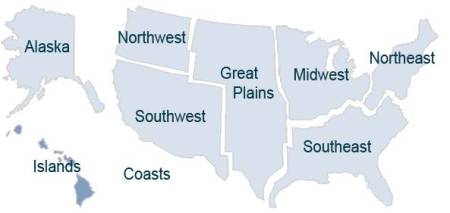Adapted from: Global Climate Impacts in the United States. T.R. Karl, J.M. Mellilo, and T.C. Peterson (eds.). Cambridge University Press, 2009. Available online at USGCRP Regional Climate Change Impacts

Climate change presents unique challenges to U.S.-affiliated islands, which include Hawaii, Guam, and Puerto Rico. Small islands are vulnerable to sea-level rise, coastal erosion, extreme weather events, coral reef bleaching, ocean acidification, and contamination of freshwater resources with saltwater. The islands have experienced rising temperatures and sea level in recent decades.
Projections for the rest of this century suggest continued increases in air and ocean surface temperatures in both the Pacific and Caribbean, an overall decrease in rainfall in the Caribbean, and an increased frequency of heavy downpours nearly everywhere. Hurricane wind speeds and rainfall rates are likely to increase with continued warming. Pacific islands are projected to receive increased rainfall during the summer months. Island coasts will be at increased risk of inundation due to sea-level rise and storm surge with major implications for coastal communities, infrastructure, natural habitats, and resources.
Key issues for islands include:
- Freshwater availability is likely to decline. Most island communities in the Pacific and Caribbean have limited sources of freshwater, so a decline in its availability would have significant implications for island communities, economies, and resources. Many islands depend on freshwater lenses below the surface, which are recharged by precipitation. Changes in precipitation, such as the significant decreases projected for the Caribbean given higher emissions of greenhouse gases, are thus a cause of great concern. Sea-level rise will affect islands’ water supplies by causing an increased frequency of flooding due to storm high tides and by causing saltwater to contaminate the freshwater lens. Water pollution, such as from agriculture or sewage, is likely to be exacerbated by storms and floods. This can contaminate freshwater supplies, affecting public health.
- Sea-level rise and coastal storms will make islands vulnerable to coastal flooding. Flooding will become more frequent, and some coastal land will be permanently lost as the sea inundates low-lying areas and shorelines erode. Coastal flooding and loss of land could damage communities, roads and other infrastructure, and ecosystems. Among the many vulnerable locations are the low-lying Northwestern Hawaiian Islands, which have a high concentration of threatened and endangered species, including some that exist nowhere else. Hurricanes and other storm events cause major impacts to island communities including loss of life, damage to infrastructure and other property, and contamination of freshwater supplies. With further warming, peak wind speeds and rainfall associated with hurricanes and other tropical cyclones are likely to intensify. Combined with sea-level rise, this would cause higher storm surge levels.
- Changes in coastal and marine ecosystems will have major implications for tourism and fisheries. Coral reefs are particularly sensitive to the impacts of climate change. Even small increases in water temperature can cause coral bleaching, when the symbiotic algae living within coral polyps depart from the system, either temporarily or permanently. Ocean acidification due to rising carbon dioxide levels poses an additional threat to coral reefs and the rich ecosystems they support. Fisheries feed island people and island economies. Nearly 70 percent of the world’s annual tuna harvest comes from the Pacific Ocean. Climate change is projected to cause a decline in tuna stocks and an eastward shift in their location.
Adapted by Melanie Lenart, University of Arizona
Other Regional Climate Change Impacts from USGCRP:
- Northeast U.S.
- Southeast U.S.
- Midwest
- Great Plains
- Southwest U.S.
- Northwest U.S.
- Alaska
- Coastal United States
